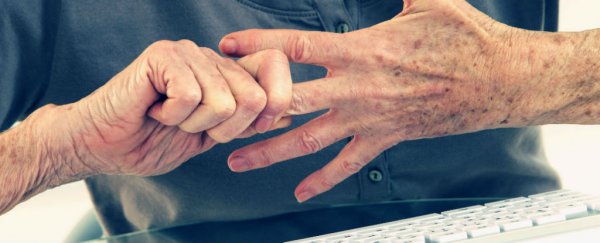Scientists have used ultrasound machines to figure out exactly what's going on in our joints when we crack them, putting an end to a decades-old debate about where that distinctive cracking sound comes from.
Back in April 2015, researchers from the University of Alberta published a paper based on MRI imaging of finger joints being cracked saying that the popping sound is caused by the formation of air bubbles that form in the fluid that surrounds our joints - called synovial fluid.
But ultrasound machines can record what's going on inside our bodies up to 100 times faster than MRIs, so another team of scientists decided to investigate this claim further at the end of 2015.
Led by radiologist Robert D. Boutin from the University of California, Davis, the team recruited 40 healthy participants, 30 of whom were regular joint-crackers, and 10 who were not. Of those who were habitual crackers, the older ones admitted to cracking their knuckles up to 20 times a day for the past 40 years.
The participants were asked crack the knuckle at the base of each finger, known as the metacarpophalangeal joint (MPJ), while being observed through an ultrasound machine. They ended up imaging 400 MPJ cracks, and recorded the sounds so they knew which ones came with a 'pop'.
While the researchers expected to see something occur within the joints - Boutin told Rachel Feltman at The Washington Post back in 2015 that ultrasound machines can capture events 10 times smaller than MRIs are capable of - they weren't prepared for the result to be so… explosive.
"What we saw was a bright flash on ultrasound, like a firework exploding in the joint," Boutin said. "It was quite an unexpected finding."
The flashes in the ultrasound were coupled so consistently with the popping sound that the researchers could predict with 94 percent accuracy which MPJ cracks 'popped' just by looking at the images.
The researchers suspect that the cracking and visual flash in the ultrasound images is related to changes in pressure that occur in the synovial fluid, as Boudin explained to Richard Hartley-Parkinson at the Metro:
"There have been several theories over the years and a fair amount of controversy about what's happening in the joint when it cracks. We're confident that the cracking sound and bright flash on ultrasound are related to the dynamic changes in pressure associated with a gas bubble in the joint."
But a big mystery still remains.
Back in 1947, a paper was published saying that the popping sound occurred when a bubble first formed in the synovial fluid of the joint.
This hypothesis was refuted 30 years later when another group of researchers said it made more sense that the sound came from the bubble bursting.
In April 2015, the University of Alberta team backed up the original bubble-forming hypothesis with their MRI recordings, but they still hadn't come up with any conclusive proof. So which is it, does the sound result from a bubble popping in the joint or from a bubble being created in the joint?
"That's a surprisingly tough question to answer," Boudin told Feltman at The Washington Post.
"I will tell you that we consistently saw the bright 'flash' in the joint only after we heard the audible crack. Never the other way around. Perhaps that supports the bubble formation theory, not the bubble popping theory."
What the researchers can say is they detected no immediate pain, swelling, or damage being done to the joints as they were cracked, and found no discernible difference between the joints of their habitual knuckle-crackers and those who never did it.
This backs up the results of an experiment by a Californian medical doctor who spent 60 years cracking the knuckles on one hand and not the other, only to find no difference between the two.
While Boudin did say more research needs to be done to confirm that no long-term damage is being done, there's also the possibility that maybe joint-cracking is actually good for us.
"After a joint cracks, the range of motion for that joint increases significantly," he told Feltman.
Please someone investigate this, we need to know!

